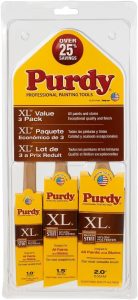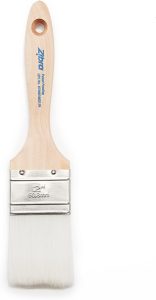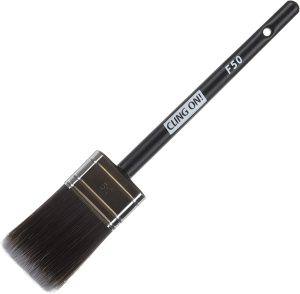Painting furniture can completely transform its look, breathe new life into worn-out pieces, and provide you with a fun and rewarding DIY project. Whether you’re upcycling an old dresser, refreshing a coffee table, or giving a new coat of paint to your dining chairs, choosing the right paint brush is crucial to achieving smooth, even coverage and long-lasting results.
The right paintbrush can make all the difference in the final look of your painted furniture, and with so many options available, selecting the best one can feel overwhelming. In this guide, we’ll walk you through the different types of paintbrushes for furniture, key considerations when making your choice, and our top recommendations for the best paint brush to paint furniture.
We’ll also answer some frequently asked questions to ensure that you’re fully prepared for your next furniture painting project.
Why Choosing the Right Paintbrush is Important
The quality of your paintbrush directly impacts the finish and durability of your paint job. Here’s why it matters:
- Smooth and Even Coverage: The right paintbrush helps ensure that the paint is applied evenly, without streaks, brush marks, or patches. A high-quality brush can reduce the need for multiple coats and provide a professional-looking finish.
- Avoiding Bristles in Your Paint Job: Low-quality brushes shed bristles, which can end up in your paint and create imperfections. Good brushes keep their bristles intact, providing a clean finish.
- Achieving the Desired Texture: Different brushes create different textures. Whether you want a smooth finish, a distressed look, or a textured effect, the right brush can help you achieve your desired style.
- Ease of Use: A well-designed paintbrush is easier to handle, reducing hand fatigue and making your painting process smoother and more enjoyable.
- Durability and Long-Lasting Results: A good paintbrush is durable and designed to withstand multiple painting projects. Investing in quality brushes saves you money in the long run, as they require fewer replacements.
Key Factors to Consider When Choosing a Paintbrush for Furniture
Before we dive into our top recommendations for the best paint brushes, let’s take a look at the key factors to consider when choosing a paintbrush for your furniture painting project:
1. Type of Paint
The type of paint you plan to use whether it’s latex, oil-based, chalk paint, or milk paint will influence the type of brush you need. For example:
- Latex Paint: Synthetic brushes with nylon or polyester bristles work well with latex paints.
- Oil-Based Paint: Natural bristle brushes (made from animal hair) are ideal for oil-based paints as they absorb and release the paint more smoothly.
- Chalk Paint: Chalk paint brushes are typically flat, with stiff bristles that help create a distressed look, but a general-purpose synthetic brush can work just as well.
- Milk Paint: Milk paint brushes tend to have more flexible bristles and a rounded shape to give an antique finish.
2. Brush Shape and Size
The shape and size of the brush will affect your ability to reach different areas of your furniture. Here are some common brush shapes:
- Flat Brushes: These brushes are great for covering large flat surfaces like tabletops, dressers, and cabinet fronts.
- Angle Brushes: An angled brush provides better control when painting corners, edges, or intricate designs. It’s perfect for painting detailed furniture like chairs and tables with ornate legs.
- Round Brushes: These are best for adding fine details, such as painting spindles or curvy sections of furniture.
3. Bristle Type
The type of bristles in a paintbrush is essential for the finish you’ll get. There are two main categories of bristles: natural and synthetic.
- Natural Bristles: Made from animal hair (typically hog or sable), natural bristles are excellent for oil-based paints as they are more absorbent and release paint smoothly. They also work well for achieving a smooth finish.
- Synthetic Bristles: Synthetic brushes are made from nylon, polyester, or a combination of both. They are ideal for water-based paints (like latex paints) and tend to hold their shape better than natural brushes, making them more durable for long-term use.
4. Handle Comfort
A brush with a comfortable handle can make your painting process easier and reduce hand fatigue. Look for brushes with ergonomically designed handles that provide a comfortable grip, especially if you’re working on a large furniture piece.
5. Durability
A well-made brush will last longer, maintain its shape, and hold up to repeated use. Investing in high-quality brushes ensures that you won’t have to replace them often, making your projects more efficient and cost-effective in the long run.
Top 5 Best Paint Brush to Paint Furniture
Now that you know the factors to consider, let’s look at our top recommendations for the best paintbrushes for furniture painting. We’ve selected options for different types of paints and furniture pieces to give you a variety of choices based on your needs.
1. Purdy 144080340 XL Series Dale Angled Brush

Best for Precision and Detail Work
Overview: The Purdy XL Series Dale Angled Brush is known for its ability to handle fine details and hard-to-reach corners with ease. Its angled shape allows for precise cutting-in, making it ideal for intricate furniture painting projects.
Key Features:
- Angled bristles for control and precision.
- Suitable for both latex and oil-based paints.
- High-quality synthetic bristles that minimize shedding.
- Comfortable, ergonomic handle for extended use.
Why It’s Great for Furniture Painting: This brush is perfect for painting intricate furniture pieces with tight spaces, such as chairs, legs, and moldings. The angled bristles help you create crisp, sharp lines along edges and corners.
2. Wooster Silver Tip Paintbrush

Best for Smooth, Professional Finish
Overview: The Wooster Silver Tip Paintbrush is a high-quality synthetic brush designed to work with all types of paints, including latex, chalk, and milk paint. It’s specifically engineered to deliver a smooth, streak-free finish, which is ideal for furniture surfaces.
Key Features:
- Soft synthetic bristles for a smooth finish.
- High paint capacity for efficient coverage.
- Durable construction for long-lasting performance.
- Comfortable handle that reduces hand fatigue.
Why It’s Great for Furniture Painting: The Silver Tip brush provides an excellent finish without leaving visible brush strokes, making it a top choice for those looking for a flawless, professional-looking paint job on their furniture.
3. Benjamin Moore Ultra Spec 500 Synthetic Brush

Best for Latex and Water-Based Paints
Overview: The Benjamin Moore Ultra Spec 500 Synthetic Brush is designed to provide excellent results with latex and water-based paints. The brush’s synthetic bristles allow for smooth application, while its durable construction ensures a long lifespan.
Key Features:
- Synthetic bristles designed for use with latex and water-based paints.
- Flexible, durable bristles that provide even paint distribution.
- Comfortable, ergonomic handle for easy use.
- Ideal for furniture with flat surfaces like tabletops and cabinet doors.
Why It’s Great for Furniture Painting: If you’re working with water-based paints like latex, this brush is an excellent choice. It offers smooth, even coverage and a clean finish, making it perfect for large surfaces like dresser tops, tables, and shelves.
4. Zibra 2” Paint Brush

Best for DIY Furniture Projects
Overview: The Zibra 2″ Paint Brush is designed specifically for DIY enthusiasts and is a great option for tackling various furniture projects. It’s perfect for painting smaller furniture pieces or adding finishing touches to larger projects.
Key Features:
- Versatile 2-inch size for easy handling.
- Ideal for chalk paint, milk paint, and latex paints.
- Flexible bristles for smooth application.
- Comfort-grip handle for better control.
Why It’s Great for Furniture Painting: The Zibra 2″ brush is versatile and can be used for a variety of furniture painting techniques, including distressing and layering with chalk paint. Its compact size is ideal for smaller projects or detailing intricate areas of furniture.
5. Cling On! Professional Paint Brush

Best for Chalk and Milk Paint
Overview: Cling On! Professional Paint Brushes are designed for use with chalk paints, milk paints, and other similar materials. These brushes feature high-quality synthetic bristles that are designed to hold paint effectively and apply it smoothly.
Key Features:
- Synthetic bristles for high paint capacity.
- Great for chalk, milk, and mineral paints.
- Ergonomic handle for comfortable use.
- No shedding or streaking, making it perfect for a smooth finish.
Why It’s Great for Furniture Painting: If you’re working with chalk paint or milk paint, Cling On! brushes are some of the best available. They provide smooth, even coverage with no brush strokes, ensuring a flawless finish for your painted furniture.
FAQ on Best Paint Brush to Paint Furniture
1. Can I use any paintbrush to paint furniture?
While it’s possible to use almost any paintbrush, using one specifically designed for furniture painting ensures a smoother finish, better coverage, and less shedding. It’s best to choose a brush suited for the type of paint you’re using.
2. What size brush should I use for painting furniture?
The size of the brush depends on the size of the furniture and the areas you need to cover. Smaller brushes (1-2 inches) are ideal for detailed work, while larger brushes (2-4 inches) work well for larger surfaces like tabletops and dressers.
3. How do I prevent brush strokes when painting furniture?
To avoid brush strokes, use high-quality brushes with synthetic bristles, apply thin layers of paint, and work in small sections. You can also use a paint conditioner to help the paint flow smoothly and level out as it dries.
4. Can I use a foam brush for painting furniture?
Foam brushes are great for smooth finishes, but they are not as durable or precise as bristle brushes. They can work for small projects or touch-ups but may not provide the best results for large furniture pieces.
5. Should I use a natural or synthetic bristle brush for furniture painting?
For latex paints, synthetic brushes are generally preferred because they offer better control and won’t swell with water. For oil-based paints, natural bristle brushes provide smoother coverage and better absorption.
6. How do I clean my paintbrush after painting furniture?
After painting, clean your brush thoroughly with soap and water for water-based paints, or with mineral spirits for oil-based paints. Proper cleaning ensures your brushes last longer and maintain their shape.
7. Can I use the same brush for different types of paint?
It’s best to use different brushes for different types of paint. Using a brush specifically designed for latex paints for oil-based paints can affect the finish. It’s advisable to clean your brush thoroughly if switching between paint types.
Conclusion
Choosing the right paintbrush for your furniture painting project is essential for achieving professional-quality results. Whether you’re tackling intricate details or covering large flat surfaces, there’s a brush designed to meet your needs.
From the Purdy XL Series Dale Angled Brush for precision work to the Wooster Silver Tip Brush for a smooth finish, each of these top choices offers excellent performance and durability. With the right tools in hand, your furniture painting project will be a success, leaving you with beautifully transformed furniture pieces to enjoy for years to come.


Leave a Reply